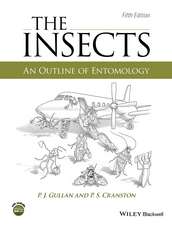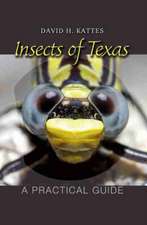Chemical Ecology of Insects 2
Autor R. T. Carde, W. J. Bellen Limba Engleză Paperback – 30 iul 1995
Chemical Ecology of Insects 2 brings together an internationally respected group of experts covering such topics as chemoreception and integration, orientation mechanisms, plant-insect interactions and insect-insect interactions. An important benefit of these reviews lies in the identification of the boundaries of our current knowledge and the most profitable areas in which we should expect these areas to develop.
This important work will appeal to entomologists and ecologists working directly with insects. In addition, plant scientists interested in the interaction of plants and insects will find much valuable information. The book is intended to benefit both field and laboratory researchers as well as advanced students.
| Toate formatele și edițiile | Preț | Express |
|---|---|---|
| Paperback (1) | 1218.17 lei 6-8 săpt. | |
| Springer Us – 30 iul 1995 | 1218.17 lei 6-8 săpt. | |
| Hardback (1) | 1231.01 lei 6-8 săpt. | |
| Springer Us – 30 iul 1995 | 1231.01 lei 6-8 săpt. |
Preț: 1218.17 lei
Preț vechi: 1485.57 lei
-18% Nou
Puncte Express: 1827
Preț estimativ în valută:
233.10€ • 253.99$ • 196.42£
233.10€ • 253.99$ • 196.42£
Carte tipărită la comandă
Livrare economică 23 aprilie-07 mai
Preluare comenzi: 021 569.72.76
Specificații
ISBN-13: 9780412039614
ISBN-10: 0412039613
Pagini: 433
Ilustrații: IX, 433 p.
Dimensiuni: 152 x 229 x 25 mm
Greutate: 0.61 kg
Ediția:Softcover reprint of the original 1st ed. 1995
Editura: Springer Us
Colecția Springer
Locul publicării:New York, NY, United States
ISBN-10: 0412039613
Pagini: 433
Ilustrații: IX, 433 p.
Dimensiuni: 152 x 229 x 25 mm
Greutate: 0.61 kg
Ediția:Softcover reprint of the original 1st ed. 1995
Editura: Springer Us
Colecția Springer
Locul publicării:New York, NY, United States
Public țintă
ResearchDescriere
During the past decade, the study of the chemical structures used by insects has advanced from a subject that could be reviewed in a single volume to a vastly more advanced level. This important new volume brings together a focused group of reviews that offer perspective on the most interesting advances in insect chemical ecology.
Chemical Ecology of Insects 2 brings together an internationally respected group of experts covering such topics as chemoreception and integration, orientation mechanisms, plant-insect interactions and insect-insect interactions. An important benefit of these reviews lies in the identification of the boundaries of our current knowledge and the most profitable areas in which we should expect these areas to develop.
This important work will appeal to entomologists and ecologists working directly with insects. In addition, plant scientists interested in the interaction of plants and insects will find much valuable information. The book is intended to benefit both field and laboratory researchers as well as advanced students.
Chemical Ecology of Insects 2 brings together an internationally respected group of experts covering such topics as chemoreception and integration, orientation mechanisms, plant-insect interactions and insect-insect interactions. An important benefit of these reviews lies in the identification of the boundaries of our current knowledge and the most profitable areas in which we should expect these areas to develop.
This important work will appeal to entomologists and ecologists working directly with insects. In addition, plant scientists interested in the interaction of plants and insects will find much valuable information. The book is intended to benefit both field and laboratory researchers as well as advanced students.
Cuprins
Preface. Contributors. Chemoreception and integration. 1. Behavior and integration; M.O. Harris, S.P. Foster. 2. Effects of experience on host-plant selection; E.A. Bernays. 3. Parasitoid foraging and learning; L.E.M. Vet, W.J. Lewis, R.T. Cardé. Orientation mechanisms. 4. The role of chemo-orientation in search behavior; W.J. Bell, L.R. Kipp, R.D. Collins. Plant-insect interactions. 5. Host-tree chemistry affecting colonization of bark beetles; J.A. Byers. 6. Host-plant choice in Pieris butterflies; F.S. Chew, J.A.A. Renwick. Insect-insect interactions. 7. Trail and territorial communication in social insects; J.F.A. Traniello, S.K. Robson. 8. The chemical basis for nest-mate recognition and mate discrimination in social insects; B.H. Smith, M.D. Breed. 9. Chemical communication in the true bugs and parasitoid exploitation; J.R. Aldrich. 10. Propaganda, crypsis and slave-making; R.W. Howard, R.D. Akre.
Recenzii
`This book distinguishes itself in the last section, with four chapters devoted mostly to sociochemistry. These four chapters are particularly noteworthy-synthetic, well-integrated, provocative, and accompanied by eye-popping comprehensive bibliographies.'
Ecology
`This volume contains ten review chapters by international experts on the ways in which chemical cues modify ecological interactions. Topics covered include chemoreception and integration; orientation; and plant-insect interactions. Speculations on the ultimate selective factors maintaining the behaviours are also included.'
Aslib Book Guide
Ecology
`This volume contains ten review chapters by international experts on the ways in which chemical cues modify ecological interactions. Topics covered include chemoreception and integration; orientation; and plant-insect interactions. Speculations on the ultimate selective factors maintaining the behaviours are also included.'
Aslib Book Guide









